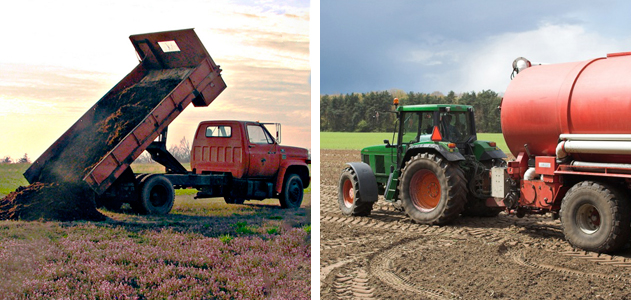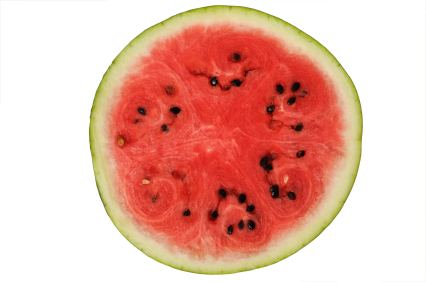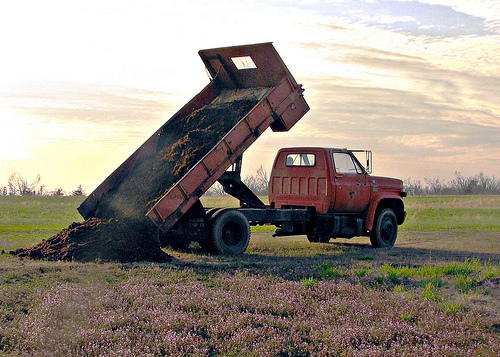 What’s the difference?: What seemed like organic fertilizer to farmers could have been spiked with the synthetic kind.Truck photo (left): Iris Shreve Garrott
What’s the difference?: What seemed like organic fertilizer to farmers could have been spiked with the synthetic kind.Truck photo (left): Iris Shreve Garrott
It’s no secret that the organic food industry has seen explosive growth, taking only a mild drubbing through the recession and then continuing its ascent. At the heart of that growth has been trust — consumers are willing to shell out more bucks for organic because the food’s been grown without synthetic chemicals, with that claim verified from farm to market.
Yet two major cases of federal fraud have been filed in the past six months, rocking the California farming world and alleging that probably millions of pounds of produce sold as organic over several years weren’t worthy of the label.
So why haven’t you heard about this? Because the shady practices came from a side of the farming world that few shoppers think about: the fertilizer industry. And the real dupes weren’t consumers but organic farmers.
In March, Kenneth Nelson Jr. was indicted by a federal grand jury on 28 counts of mail fraud as part of long-running scheme to sell liquid fertilizer through Port Organic Products and several related businesses. He claimed the juice was made from fish meal, bird guano, and other organic-friendly products — but it turns out it may have been spiked with far cheaper synthetic fertilizer.
His was just the latest case. In October, FBI agents swooped into LAX and arrested Peter Townsley, who headed California Liquid Fertilizer in the Salinas Valley, the heart of the state’s produce industry. Although the company’s product was labeled as natural fertilizer made from fish, it also allegedly contained synthetic nitrogen — and it had been widely used by organic farmers for years.
“This was probably one of the most significant cases of fraud in the history of the NOP,” said Miles McEvoy, deputy administrator of the USDA’s National Organic Program (NOP).
You can think of Townsley as the Bernie Madoff of the organic farming world, arrested and charged with mail fraud for submitting false statements about the juice, called Biolizer XN. Farmers applied his synthetic-nitrogen-rich fertilizer and then sold the crop as organic. Consumers at the end of the line were buying products they thought were grown organically but technically weren’t.
Secret sauce
Fertilizer has been a weak link in the organic chain for a number of reasons, although it hasn’t gotten little attention outside organic circles.
First, fertilizer companies fall outside of the USDA’s National Organic Program, so they aren’t required to be inspected by third parties and certified in the same way that farmers or food processors are. While organic rules spell out what can and can’t be applied to fields — and synthetic fertilizer is definitely not allowed — regulators at the USDA have no authority to take the next step and certify fertilizer manufacturers. Fertilizer oversight has rested with states.
Second, fraudulent fertilizer has been hard to detect. Only recently have tests evolved that can trace the source of fertilizer ingredients.
Finally, fertilizer is pretty far down the list of consumers’ reasons for buying organic, which tend to prioritize avoiding chemical residues over esoteric soil fertility practices.
“People are much more freaked out about pesticides than fertilizers,” said Brian Baker, who evaluated substances at the Organic Materials Review Board (OMRI) and now heads the Institute for Sustainability at Alfred State College in New York.
But this might be ecologically shortsighted. Baker points out that the biggest difference between organic and conventional farming isn’t the use or avoidance of chemical pesticides, “but the way the nitrogen cycle is managed.” Soils are often doused with synthetic fertilizers to raise yields, but the end result can be more pest and disease pressures, which in turn can lead to more pesticide use.
Instead of relying on petroleum- or ammonia-derived fertilizers to energize plants, organic farmers feed their soil with crop rotations, cover crops, and compost. They may supplement with concentrated fertilizers such as fish emulsion, but that’s an expensive measure and not the core of the soil fertility regime.
So how does a farmer know a substance conforms with organic methods? They rely on two bodies for help.
Both the nonprofit Organic Materials Review Institute in Eugene, Ore., and the Washington State Department of Agriculture evaluate products such as fertilizers, soil amendments, and pest controls, then “list” the substance as allowable. (Even home gardeners can make use of the OMRI site to check out products). But they have no statutory authority to investigate or ban a product. At best, they can withhold a listing. Farmers can still use a product, but do so at their own risk.
With Biolizer XN, however, there was no grey area: By allegedly submitting false statements to OMRI, California Liquid Fertilizer’s product made the preferred list. And farmers used the stuff — from as early as 2000 until 2007.
Baker, the former OMRI official, said that he had inspected the company’s plant, though he noted that finding evidence of fraud was especially difficult — not only in this case but in others. He recalled that in the 1990s, one company claimed that a particularly potent organic fertilizer came from a secret lake bed in the Midwest.
“Every time we asked to see the lake, they refused,” he said. Turns out the lake didn’t exist.
That was the drill with questionable substances. OMRI would ask for documentation, set deadlines, and on some instances, ask to inspect a plant. “They’d fail to get back to us, or a deadline would lapse and we would not approve the product,” said Baker.
Stinking to high heaven
California Liquid Fertilizer was an especially popular product with a third of the California market, according to the Sacramento Bee, which broke the story. While growers for Earthbound, the largest organic produce company in the nation, and Driscoll’s — the big berry grower — had used the product, it wasn’t confined to large farms. Even organic CSAs used it.
Port Organic’s products were popular as well, becoming the largest source of organic fertilizer to farmers in the western half of the U.S., according to the federal indictment, generating $9 million in profits and a Porsche and BMW for Nelson.
These fertilizers tend to be applied in the winter months, when produce grow more slowly, and to heavy-feeding, shallow-rooted crops such as strawberries that produce month after month. The products were attractive because they were potent and could be delivered through drip irrigation lines that run down field rows and water plants. Fish emulsions with organic material can plug up drip lines.
“It was the cheapest stuff around and very popular,” said Zea Sonnabend, a policy specialist and organic inspector at California Certified Organic Farmers (CCOF), the state’s largest certifier.
Although Sonnabend said there had been suspicions about the products, notably from competitors, CCOF could not block a product based on rumor. While OMRI had misgivings about California Liquid Fertilizer, state regulators in California had asked OMRI to back off, pending the results of a state investigation that began in 2005. So with the OMRI seal, organic farmers continued to apply the stuff.
A state investigator in 2006 found rail cars that had delivered ammonium nitrate to the California Liquid Fertilizer plant, reported the Bee. As a result of the investigation, the product was pulled off the market in 2007, with no admission of guilt. The transgression didn’t come to light until late 2008.
Then, in the second instance of alleged fraud, the FBI raided Nelson’s Port Organics in 2009 and found a tank of ammonia under the floor boards in its Bakersfield, Calif., headquarters. The ammonia was used to make synthetic fertilizer sold as organic.
Certifiers made a decision not to punish farmers who had unwittingly applied the products, even though synthetic fertilizers aren’t allowed under organic regulations. There was, after all, no admission of wrongdoing. Plus, everyone from OMRI to the farmers were duped.
If certifiers had taken that step — a move that ultimately would have been decided by the USDA — California organic farms, which account for 22 percent of organic farms in the nation and more than 430,000 acres of organic crops, would have taken a big hit. After all, it takes three years to bring land back to organic once a prohibited substance is applied. The $25 billion industry might have stumbled too, given that organic produce is the largest single segment.
“It would have jeopardized a huge amount of crops at great cost if all growers had to go out of organic for three years,” said Charles Benbrook, chief scientist at The Organic Center, an industry-backed think tank.
That risk is now over, since it has been three years since any of this stuff was applied and all fields would technically be free of a “disallowed” substance. Even if Townsend and Nelson are found guilty, farmers and the industry won’t suffer.
Trust busters
The breadth of organic farming in California may have made it especially vulnerable to fraud, since it presents a welcome market — for anyone. But the industry’s maturity might also be a counterweight to this happening again, because it has prompted more vigilance.
A California state law overseeing organic fertilizer went into effect in 2011, which requires inspection and certification of fertilizer sold in the state. The program may become a kind of pilot for the National Organic Program, the USDA’s McEvoy said.
In 2009, the NOP also began requiring that all liquid fertilizers with greater than 3 percent nitrogen content must be reviewed by OMRI or an accredited certifier.
Earthbound didn’t wait for the new state law to take effect. “By the time the regulators get involved it’s often too late,” said Will Daniels, Earthbound’s vice president of quality, food safety, and organic integrity.
Once the scandal broke, the company began testing fertilizers. It now posts the information on an internal website so contract growers can see what soil amendments are approved.
Testing is a big part of the company’s quality assurance regime. Aside from fertilizer, it also tests organic compost for pathogens. Salad mix and other crops delivered to its processing plants are tested for pesticides and pathogens. Then once they’re washed and bagged, they’re sampled again — a particularly rigorous program the rest of the industry has yet to emulate.
But Earthbound has a reason for being so thorough. Its parent company, Natural Selection Foods, processed the spinach greens for Dole that were contaminated with E. coli and ended up sickening 205 people and killing two in 2006, only a year before the fertilizer case came to light.
While fraudulent fertilizer may not be in the same league as tainted spinach, the two cases have a lot in common. In both, a central source made its way into the middle of a robust system, tainting everything in its path. But they also have a notable difference: E. coli arose from the environment; while for the fake organic fertilizers, the root cause was fraud.
One way to prevent these type of incidents would be to beef up oversight — something that the Food Safety Modernization Act that passed Congress late last year would attempt to do for, say, salad mix. California’s state law will also mean greater oversight and inspections of fertilizer makers, adding another layer of assurance for farmers and creating a potential model for the National Organic Program.
But perhaps the biggest lesson from the case is that every link in the chain of the organic industry, from farmer to product testers to certifiers, should have been more suspicious all along. If the fertilizers were so good, so cheap, and so much more potent than the norm, maybe they were simply too good to be true.
In other words, everyone was duped, but perhaps too easily. Organic consumers can only hope that the renewed sense of vigilance will be present when the next case of fraud — with fertilizers, pesticides, or false labeling — inevitably arises.



